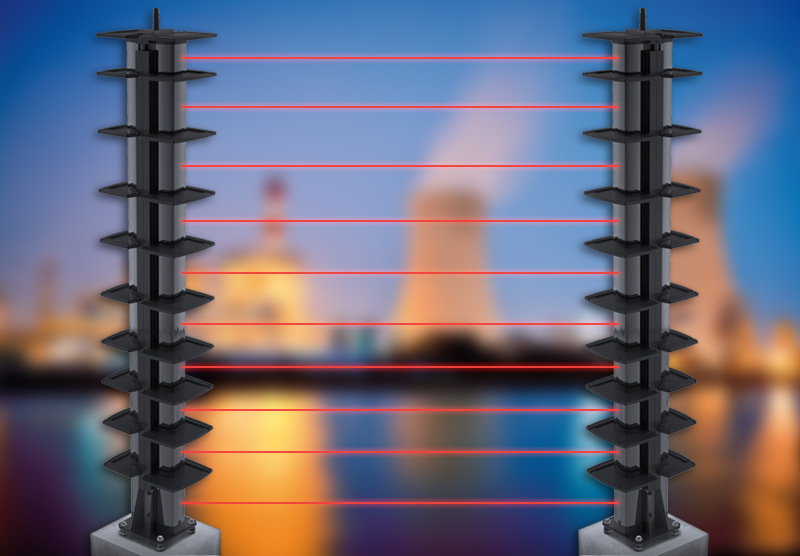Infrared barrier without civil engineering
EASY INSTALLATION : Independent barrier, no civil engineering or cabling required, towers are bolted to concreate block – operational in minutes
RELIABILITY : Communication through secure radio protocol. High probability of detection. Patented design anti-condensation / anti-ice caps prevent the formation of ice and condensation on IR cover – exceptional performance in all weather conditions
INNOVATION : 1st autonomous, long-range 328 feet (100m) infrared barrier in the industry
Overview
The SOLARIS self-contained infrared barrier towers form a “virtual” (invisible) wall/fence to detect unwanted intrusions. Powered by a solar panel and highly efficient integrated battery, installation requires little to no civil engineering.
Communication occurs through a dynamic radio mesh network (through proprietary protocol) to and from all SOLARIS towers that transmit alarm information reliably and efficiently. This communication uses the highly secure Advanced Encryption Standards (AES 128).
Each SOLARIS tower integrates a powerful radio transmitter/receiver with low power consumption.
When the infrared barrier sensor detects an intrusion, alarm information is collected by all nearby infrared towers that retransmit information automatically. The alarm message is relayed to a radio coordinator connected to the MAXIBUS Universal hub. The alarm center receives an intrusion alert notification. In the event that one SOLARIS tower is missing (or down) in the network, an alert is triggered for notification, acting like a watchdog for individual tower status reporting.
SOLARIS is an ideal solution for sites that require high-security perimeter surveillance with minimal infrastructure, cost-effectively:
- utilities / sub-stations / control centers
- nuclear plants
- correctional facilities as a secondary layer of perimeter protection
- logistics sites / storage and warehousing
- car dealerships
- industrial complexes, etc.
| Maximum range inside | 328 feet (100 m) |
| Heights and types of towers | 3.2 ft(1m) - 6.5 ft(2m) - 8 ft(2.5m) -10 ft(3m) Single and double face |
| Cells | 3 to 10 cells |
| Selectable channels | 4 |
| Alarm information | Intrusion / Disqualification / Tamper/ Anti-climbing cap/ Power failure / Low battery / Loss of radio link |
| Alarm transmission | Dynamic meshed radio network to radio coordinator |
| Radio frequency | Bandwidth 915MHz, Lora modulation, 19 selectable channels |
| Data encryption | 128 bits AES |
| Power supply | Solar panel and battery in each tower |
| Alignment aid tools | Audible and visual signals on all the towers |
| Temperature of use | -40°F to +158°F (-40°C to +70°C) |
| Electromagnetic compatibility | Compliant with European standards (CE label) |
Barriers must be installed on a stable support. Check that ground is level and will ensure stability of the columns over time.
A maximum of 10° elevation may be tolerated between the columns. In case of elevation above 10°, contact PROTECH’s sales department.
Beams must be free of vegetation coverage regardless of the season and weather condition (wind). If solar panel is covered by vegetation, it must be placed remotely.
Covers and solar panels require cleaning with a soft and damp cloth at least once a year.
The radio coordinator must be installed outside, towards the middle of the protected perimeter and as high as possible.
Check that anti-condensation/anti-frost caps are installed to ensure that the SOLARIS barriers are working at all times.
Infrared technology operates at a wavelength above that of visible light (950nm), which makes the IR beam invisible to the naked eye.
IR beams are transmitted and received by infrared cells – transmitter cells generate and send a pulsed beam to the receiver cells which capture infrared pulses and turn them into electrical signals. When an absence, loss or change in the signal occurs (loss of 95% of the transmitted signal), an intrusion alarm is triggered. To prevent interference of receiver cells by the infrared beams being transmitted, cells are multiplexed.
Multiplexing is a principal whereby infrared pulses are transmitted in a synchronized manner by an optical or wired link between transmitter and receiver towers. This feature optimizes cell alignment (“alignment feedback”). All the PROTECH IR barriers are multiplexed.
Solaris 45°
Grade Bracket: the grade bracket mounts on double-stack columns to correct uneven grades up to 45 degrees.




